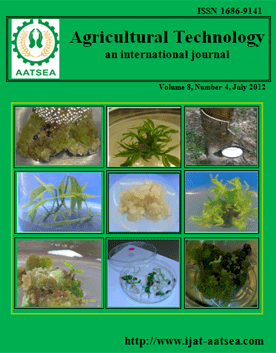ThaiScience
ThaiScience
INTERNATIONAL JOURNAL OF AGRICULTURAL TECHNOLOGY
Volume 15, No. 04, Month JULY, Year 2019, Pages 645 - 664
Rubber production system and livelihood of smallholding rubber farming system (srfs) in southern thailand: a case study in provinces of nakhon si thammarat, phatthalung and trang
Somboonsuke, B. , Yincharoen, A., Kongmanee, C. and Phitthayaphinant, P.
Abstract Download PDF
The farming system, production management, technology usage, livelihood, vulnerability, and factors was examined the influence on the vulnerability of livelihoods of smallholding rubber farmers along with other agricultural activities. The studied locations were those of Pa Bon district, Tamot district, Bang Kaeo district in Phatthalung province; Ron Phibun district and Lan Saka district in Nakhon Si Thammarat Province; and Na Yong district, Kantang district, and Yan Ta Khao district in Trang province. The number of 399 households and 60 key informants were selected as a sample group. The results indicated that working with rubber farming could be classified into 5 systems that were 1) mono-rubber-tree farming system (53.85%), 2) inter-fruit-tree with the rubber-tree farming system(14.48%) such as durian and longkong, 3) rubber-tree with rice farming system (8.27%), 4) rubber-tree with the oil-palm farming system (19.22%), and 5) rubber-tree farming with animal raising system (4.18%). For livelihoods of rubber farmer households under these 5 systems, the results reflected all 5 systems that the social capitals were quite high when the economic capitals were quite low. For the livelihood success among the 5 systems, the study indicated that to get a net income, reducing limitation strategies, and top know well-being under the oil-palm farming system had higher averaged values than all of the other systems. For the 10-year economic model (2017- 2026), the study indicated that inter-fruit-tree with the rubber-tree farming system, rubber-tree with the oil-palm farming system, and rubber-tree farming with the animal raising system had high marginal marketing when compared with the others. For the model of rubber production pattern and livelihood under rubber farming system along with other agricultural activities for sustainable development in the 3 provinces, the study classified the system into 4 sub-models s as follows:- 1) production system, 2) support system, 3) strategy and livelihood adjustment system, and 4) the resulted sustainable livelihood system.
Keywords
smallholder livelihood, rubber smallholding farm, rubber productionINTERNATIONAL JOURNAL OF AGRICULTURAL TECHNOLOGY
Published by : Association of Agricultural Technology in Southeast Asia (AATSEA)
Contributions welcome at : http://www.ijat-aatsea.com
